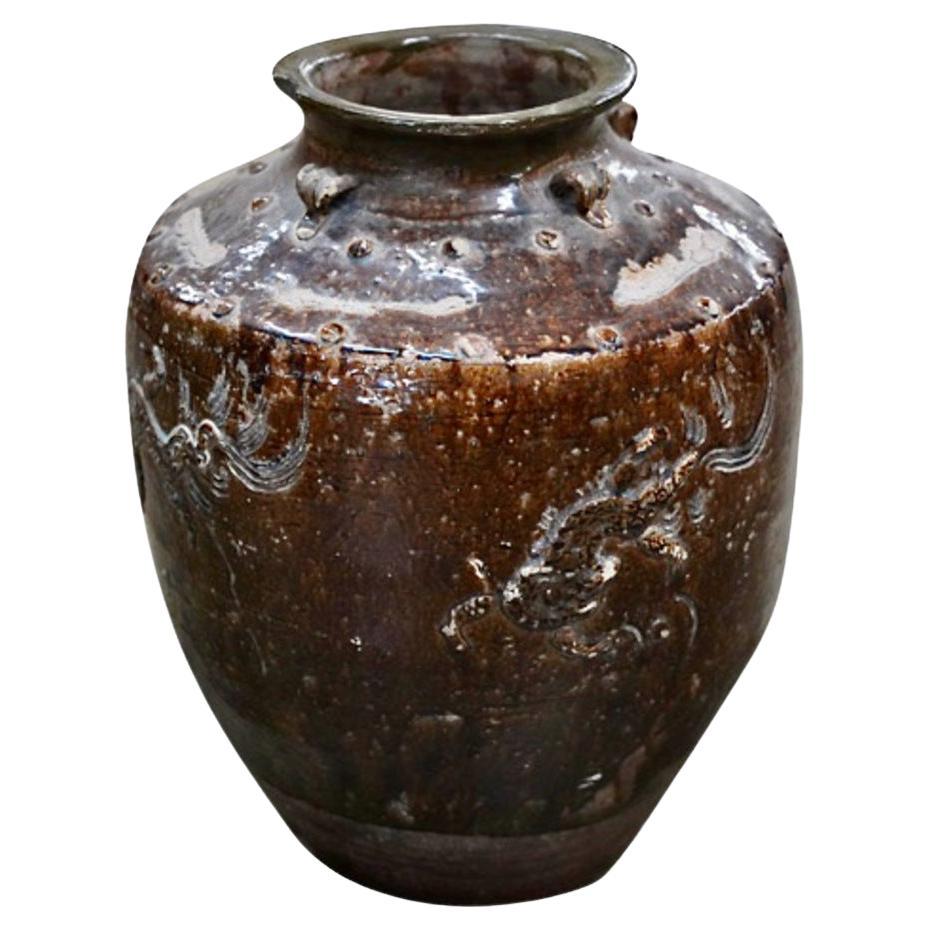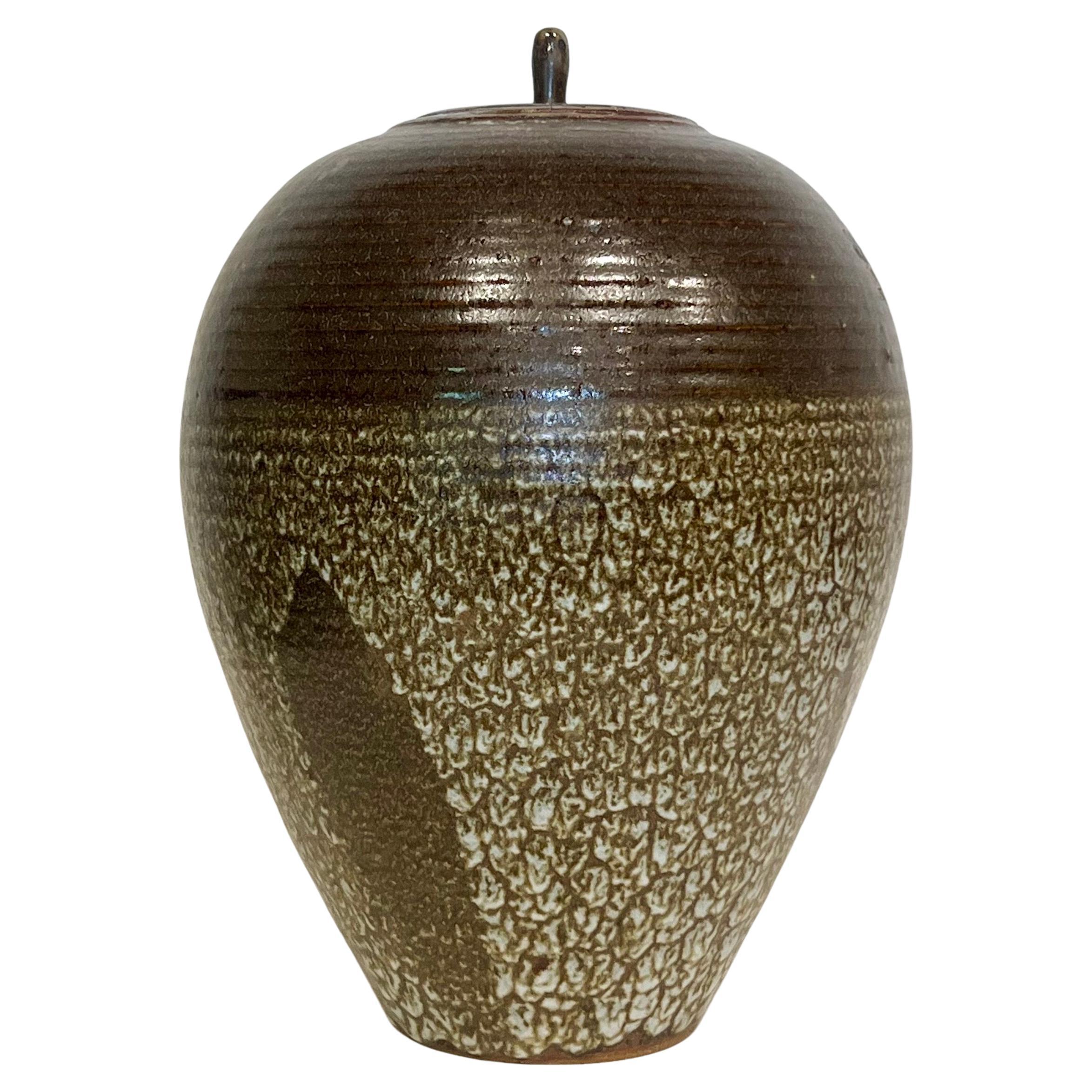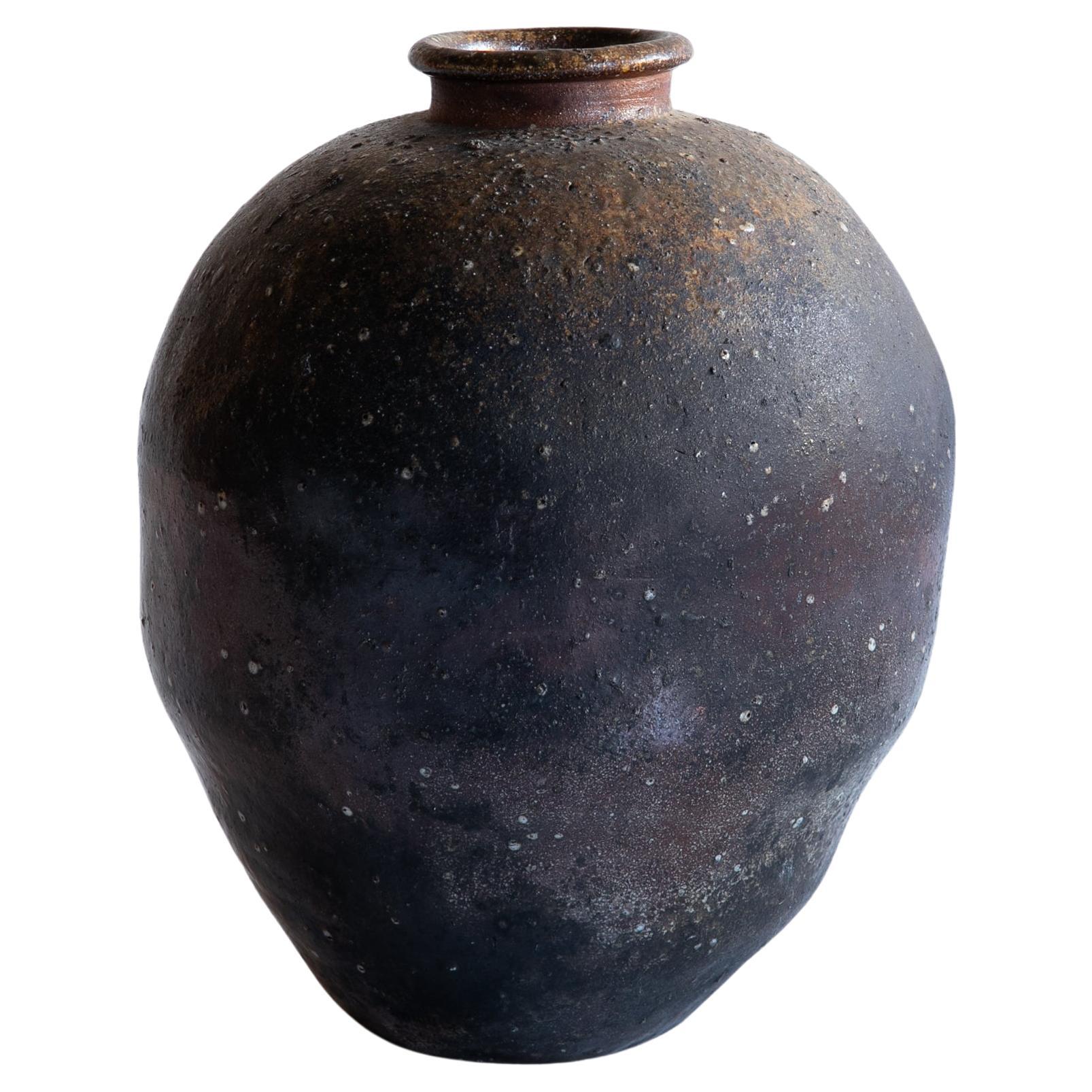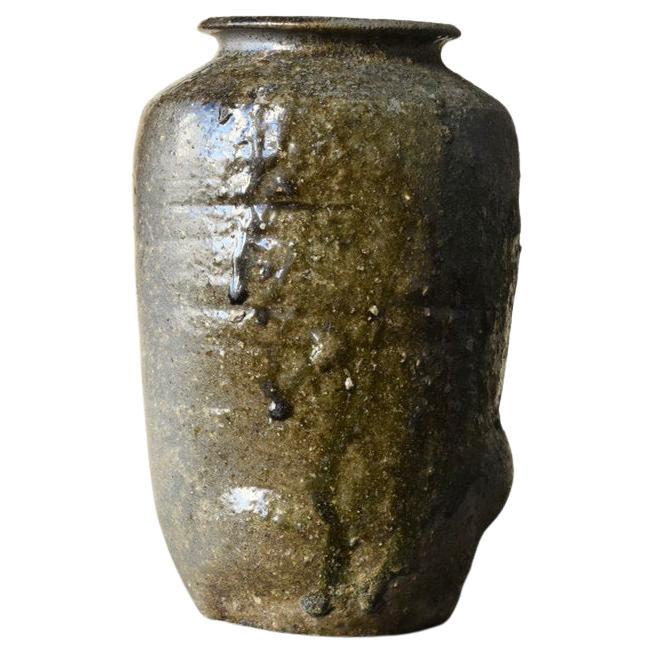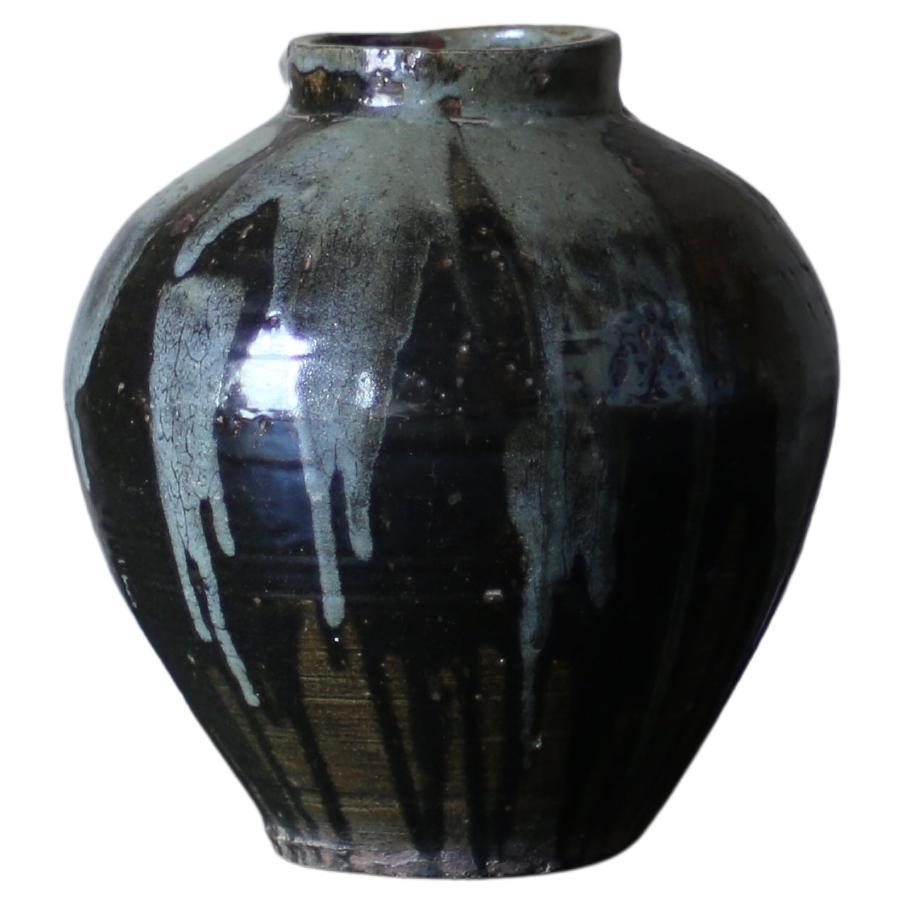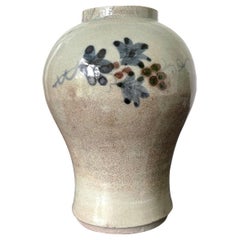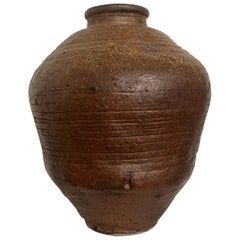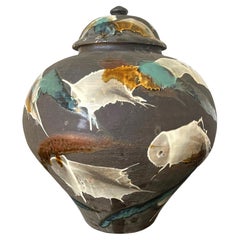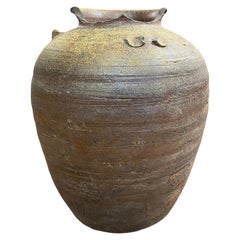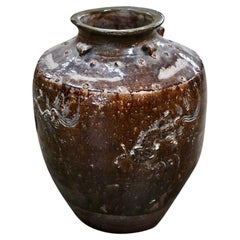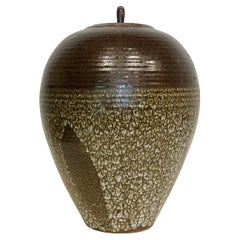Items Similar to Japanese Ceramic Seto Tea Leaf Tsubo Jar Edo Period
Want more images or videos?
Request additional images or videos from the seller
1 of 20
Japanese Ceramic Seto Tea Leaf Tsubo Jar Edo Period
$3,200
£2,443.19
€2,823.08
CA$4,492.19
A$5,007.02
CHF 2,627.01
MX$61,143.86
NOK 33,263.67
SEK 31,439.23
DKK 21,069.87
About the Item
A Japanese glazed ceramic jar with a lacquered wood lid circa 19th century of late Edo to early Meiji Period. The stoneware tsubo was used as a storage vessel for produce such as tea leaves. It was made in Seto, one of the six ancient kilns in Japan, or in the style of seto-ware.
Of classic form that was widely popular in China and Japan, the jar is well proportioned with a voluminous body with broad shoulder, a short straight neck and a large opening. The surface was covered entirely in a glossy dark-brown iron glaze with a subtle tint of green. Some kiln debris and glaze bursts were seen scattered on the shoulder, adding a wabi-sabi charm to an otherwise austere piece. Nine motifs of small jars, grouped in three in each composition, graced the surface. They were incised and filled with white slip glaze that was fired to fine crackles. The design was either a simple carved outline with empty spaces, or the entire silouette was infilled with the white glaze. Together, they form a contrasting ying and yang pattern. The symbols of empty and full jars carry a profound philosophical message that beckons the viewer to ponder about life. A black lacquered wood lid with a top-loop handle accompanies the jar, although it is hard to tell if it is original.
- Dimensions:Height: 9.5 in (24.13 cm)Diameter: 8.5 in (21.59 cm)
- Style:Edo (Of the Period)
- Materials and Techniques:
- Place of Origin:
- Period:
- Date of Manufacture:19th Century
- Condition:Wear consistent with age and use. Minor losses. Overall fine condition, a small historical chip under the rim. Lacquer lid shows wears and liquid stains on top, and a few tiny chips around the rim where it contacts the jar. All shown in detail photos.
- Seller Location:Atlanta, GA
- Reference Number:1stDibs: LU945041127882
About the Seller
4.9
Platinum Seller
Premium sellers with a 4.7+ rating and 24-hour response times
Established in 2006
1stDibs seller since 2010
565 sales on 1stDibs
Typical response time: <1 hour
- ShippingRetrieving quote...Shipping from: Atlanta, GA
- Return Policy
Authenticity Guarantee
In the unlikely event there’s an issue with an item’s authenticity, contact us within 1 year for a full refund. DetailsMoney-Back Guarantee
If your item is not as described, is damaged in transit, or does not arrive, contact us within 7 days for a full refund. Details24-Hour Cancellation
You have a 24-hour grace period in which to reconsider your purchase, with no questions asked.Vetted Professional Sellers
Our world-class sellers must adhere to strict standards for service and quality, maintaining the integrity of our listings.Price-Match Guarantee
If you find that a seller listed the same item for a lower price elsewhere, we’ll match it.Trusted Global Delivery
Our best-in-class carrier network provides specialized shipping options worldwide, including custom delivery.More From This Seller
View AllJapanese Echizen Ceramic Tsubo Fujita Jurouemon VIII
Located in Atlanta, GA
A Japanese storage jar (tsubo) made in the ancient Echizen ware tradition by Fujita Jurouemon VIII. Echizen is one of the six ancient kilns in Japan, directly influenced by the Sue ware...
Category
20th Century Japanese Modern Ceramics
Materials
Ceramic
Korean Ceramic Storage Jar Joseon Dynasty
Located in Atlanta, GA
A Korean ceramic storage jar circa 18th century of Joseon Dynasty. The jar is of a characteristic form with a bulbous upper body that tappers with a gra...
Category
Antique 18th Century Korean Other Ceramics
Materials
Ceramic
Large Japanese Antique Shigaraki Tsubo Jar
Located in Atlanta, GA
An antique Japanese stoneware storage jar, known as tsubo from Shigaraki kiln, circa 17th-18th century (early Edo possibly Momoyama period)....
Category
Antique 17th Century Japanese Japonisme Ceramics
Materials
Ceramic
Large Japanese Contemporary Ceramic Jar from Onda Yaki Kiln
By Onda Yaki
Located in Atlanta, GA
A large Japanese lidded ceramic jar from the kiln of Onda Yaki, circa 2010. The stoneware jar impresses the viewer with a robust bulbous form. Its black body is nearly unglazed but exuberantly splashed with strokes of slip glazes of white, yellow and blue. The visual effect is wonderful that it appears traditional and contemporary at the same time. The tri-color glaze calls to mind the San-Cai from Chinese Tang dynasty, yet the application is akin to abstract painting on canvas.
Onda Yaki also spelled as Onta Yaki also spelled Onta, is a type of Japanese pottery produced in and around the village of Onta in Oita Prefecture in Kyushu Island. It was founded in 1705. Closely associated with Mingei folk art, Onda ware was inscribed by the national government in 1995 as an Intangible Cultural Property
Background from Pucker Gallery where the jar was exibited and purchased.
"In his search for true folk pottery, the Japanese philosopher Soetsu Yanagi...
Category
2010s Japanese Organic Modern Ceramics
Materials
Ceramic
Large Korean Ceramic Jar Joseon Dynasty
Located in Atlanta, GA
A large Korean white porcelain jar with underglaze decoration circa late 19th century of Joseon Dynasty. The vase has a well-proportioned profile of a classic jar (known as Hangari in Korean and was being produced since 18th century from Punwon-ri Kilns) with a tall upright neck that extends to a generous opening and swelled rounded shoulder that tapers down toward the base. Many of these porcelain jars were decorated with underglaze cobalt blue painting...
Category
Antique 19th Century Korean Other Ceramics
Materials
Ceramic
Antique Chinese Ceramic Tea Leaf Storage Jar Song-Yuan Dynasty
Located in Atlanta, GA
A stoneware pottery jar used for storage, made in southern China Fujian or Guangdong province since Song Dynasty for domestic use as well as export. They were widely exported to Japa...
Category
Antique 15th Century and Earlier Chinese Archaistic Ceramics
Materials
Ceramic
You May Also Like
Japanese Antique Momoyama Edo Bizen Ware Pottery Wabi-Sabi Art Tsubo Jar Vase
Located in Studio City, CA
An absolutely stunning Bizen ware stoneware vase/jar/vessel - produced sometime during the late Momoyama period (1568-1600) / Early Edo Period (1603-1867). Bizen yaki...
Category
Antique 16th Century Japanese Edo Ceramics
Materials
Stoneware
Large Chinese Martaban Jar, Ming Dynasty
Located in Pasadena, CA
This is a large Chinese 17th Century Stoneware Martaban Jar. Martancan Jars were created to store food items such as grain, tea, oil, etc. The ...
Category
Antique Late 17th Century Chinese Chinese Export Ceramics
Materials
Terracotta
$2,380 Sale Price
20% Off
Vintage Japanese Ceramic Lidded Vessel c1970s
Located in Oakland, CA
Absolutely stunning tapered turned studio clay vessel with a beautifully sculpted lid. Amazing glaze work with cascading puffy drips. Really a handsome piece. Signed by maker.
Category
Vintage 1970s Japanese Modern Vases
Materials
Clay
Japanese Antique Pottery Jar 15th-16th Century/ Wabi-Sabi Vase/Shigaraki
Located in Sammu-shi, Chiba
I would like to introduce an attractive pot that gives you a sense of wabi-sabi.
It is "Shigaraki ware".
Shigaraki is a historical kiln located in Shiga Prefecture, Japan.
It is sa...
Category
Antique 15th Century and Earlier Japanese Edo Vases
Materials
Pottery
Very Rare Japanese Antique Pottery Jar/Beautiful Glaze/Wabisabi Vase/10th-11th
Located in Sammu-shi, Chiba
I would like to introduce a very rare Japanese antique pottery pot.
This is Japanese Sue pottery.
Sue pottery is called "sueki" in Japanese.
This type o...
Category
Antique 15th Century and Earlier Japanese Other Vases
Materials
Pottery
Japanese Antique Pottery Vase 1900s-1940s / Kasama
Located in Sammu-shi, Chiba
This ceramic vase was made in Kasama, Japan. Kasama is a traditional and famous pottery producing area.
It is very old vase.
It has a very beautiful light blue glaze and has a wond...
Category
Early 20th Century Japanese Taisho Vases
Materials
Pottery
More Ways To Browse
Japanese Ceramics Edo Period Or Earlier
Leaf Ceramics
Edo Japan
Edo Period Japan
Edo Period Japanese Art
Japanese Charm
Kiln Japanese
Edo Wood
Wabi Sabi Ceramic
Antique Iron Glaze
Japanese Lidded Jar
Large Japanese Jars
Japanese Jar Large
Japanese Crackle
White Lacquer Asian
Green Asian Vessels
Ceramic Loops
Chinese Green And Black Ceramic

